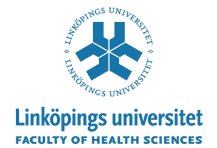 |
Visa svensk kursplan |
|
COURSE CATEGORY Fristående kurs MAIN FIELD OF STUDY SUBJECT AREA |
COURSE CODE | 8FA031 |
By the end of the course the students will be able to:
-Identify, understand and explain medical, neurobiological phenomenon
-Relate the new knowledge to cellular and molecular mechanisms
-Integrate knowledge from different biological and medical area in order to explain a neurobiological phenomenon
-Evaluate their new knowledge in relation to current research in medical neurobiology
-Discuss and evaluate the results of scientific publications
Students who have failed two times on the course or part of the course are entitled to request another examiner at the new examination occasion.
Extent of re-examination
The extent of a re-examination shall be similar to the regular examination.
Entries for examinations
Rules for entries for examination are given in the course plan. Besides are "Regulations regarding examinations and examinators" according to decision Linköpings University Dnr: LiU 1109/00-40 applied.
Students should have knowledge in cell biology, cell signalling and communication, histology and pathology of the cells/tissue in the nervous system at basic level.
Applicants with a degree from a non-Swedish university must enclose an official examination certificate for at least three years of fulltime studies in subjects with relevance for Life Science, such as biology, chemistry, medicine or corresponding. If English is not the mother tongue of the applicant, he or she must also be able to prove proficiency in English. This may be done by submitting results from an internationally recognised test e.g. the TOEFL-test or prove that the education at basic level has been performed in English. Applications must be supported by official documents issued by a recognised university or other authority.
Planning and implementation of the course shall be carried out from the wording in this course plan. The evaluation of the course should therefore consider the question how well the course agrees with the course plan. The evaluation will be written on a scheduled time point at the end of the course.
Electronic evaluation of the course in accordance with Linköping University´s regulations will in addition be done (Dnr LiU 780/06-04).
At the student´s request, course certificate is issued by the director of studies for courses or, according to delegation, by the head of the department/director of programme studies.
The course organiser at the Division of Cell Biology, Department of Biomedicine and Surgery, will provide a list of relevant literature at least two months before the start of the course.
Students should have knowledge in cell biology, cell signalling and communication, histology and pathology of the cells/tissue in the nervous system at basic level.
The course is given in such a way that both men´s and women´s experiences and knowledge are made visible and developed.
If the course is closed down, or is subject for major changes, is normally examination according to this course plan offered on totally three occasions within a year, of which one in close connection to the first examination.
|
||||||||||||||||||||||||||||||||||||||||||||||||||||||||||||||||||||||||||||||